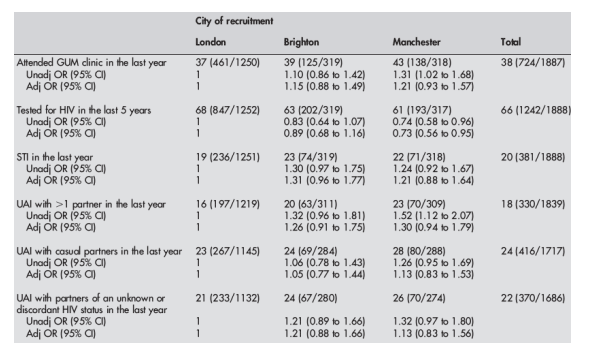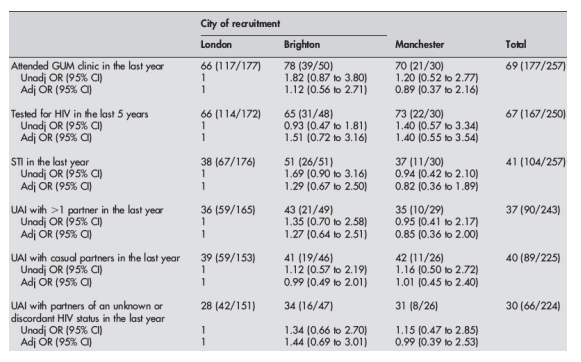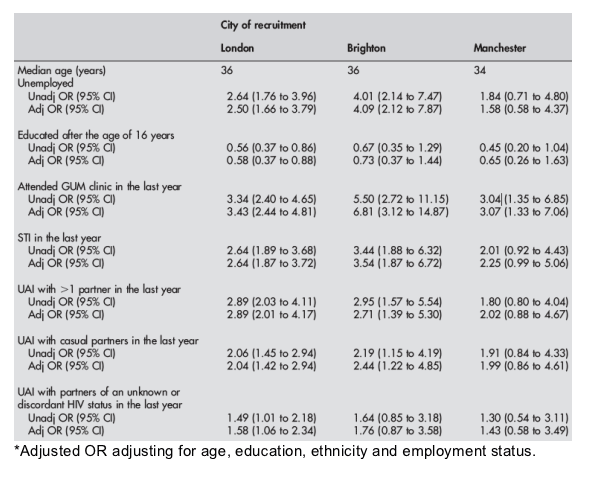| |
44% HIV+ Undiagnosed in London, UK
|
| |
| |
Over one-third of HIV infection
remained undiagnosed: survey in 3 UK cities
"A tale of three cities: persisting high HIV prevalence, risk behaviour and undiagnosed infection in community samples of men who have sex with men"
STI Online First, published on May 1, 2007
Julie P Dodds, Anne M Johnson, John V Parry, Danielle E Mercey
Department of Primary Care and Population Sciences, Centre for Sexual Health & HIV Research, University College London, London, UK
John V Parry, Virus Reference Department, Centre for Infections, Health
Protection Agency, London, UK
....The proportion of HIV-positive men whose infection was undiagnosed was high in all three cities, ranging from 33% in Brighton to 44% in London (p=0.73), 36% & Manchester....
"....There has been an increase over time in the number of MSM newly diagnosed as having HIV infection ...These results, derived from London, Brighton and Manchester, provide the means to measure the effectiveness of current HIV prevention campaigns and to inform future HIV prevention programmes. ....Results from the OraSure test demonstrated a high HIV prevalence in all three cities, with a high proportion of HIV infection remaining undiagnosed. Voluntary confidential HIV testing should be promoted in all three cities....Barriers to testing....must be addressed.... Only a small number of rapid HIV and STI testing services in the UK have been developed within the community.... Of all the men approached (in this study), 66.3% agreed to take an oral fluid test and 73.5% agreed to complete a questionnaire, demonstrating acceptability..... Our data show remarkable similarities between cities in the proportion of men reporting high-risk sexual behaviour and STIs, among both the HIV-negative and HIV-positive men..... These data demonstrate the country-wide high levels of risk behaviour, STIs and HIV prevalence, which together account for the worrying trend of continuing high HIV incidence in MSM..."
There is evidence of continuing transmission of HIV among men who have sex with men (MSM) in the UK, particularly in London, despite safer sex campaigns. MSM still form the largest group of HIV-infected people in the UK.1 There has been an increase over time in the number of MSM newly diagnosed as having HIV infection.2 Continuing detection of HIV infection among young MSM in the unlinked anonymous seroprevalence survey also suggests recent transmission.1 3
There have been significant changes in the gay scene in Britain over the last two decades, with increased numbers of commercial venues outside of London, primarily in Brighton and Manchester. These cities have thriving gay scenes, which act as a major pull for those living in the surrounding areas. Increasing levels of sexually transmitted infections (STIs) have been reported in all three cities, most notably between 1999 and 2000, with a significant increase in new syphilis cases among MSM.4 5 Rates of gonorrhoea in the UK, both inside and outside London, also increased among MSM.2 6-8 STI outbreaks were found to be associated with high rates of partner change, casual sex contacts and poor contact with sexual health services.7 9 We have previously reported on increasing levels of sexual risk behaviour in London through our community-based programme of behavioural and HIV prevalence surveillance in London.10 11 More recently, we have extended this research to other cities in response to concerns about increasing incidences of STIs.
In this paper, we report on the geographical variations between three cities commonly viewed to have the largest gay communities in the UK, specifically London, Brighton and Manchester, in the prevalence of diagnosed and undiagnosed HIV infection, genitourinary medicine (GUM) clinic attendance, STIs and unprotected anal intercourse (UAI) in the last year.
ABSTRACT
Objectives: To examine the geographical variations in HIV prevalence (diagnosed and undiagnosed), use of sexual health services, sexually transmitted infections and sexual behaviour in a community sample of men
who have sex with men in three cities in England, specifically London, Brighton and Manchester.
Methods: Cross-sectional surveys of men visiting gay community venues in three large cities in England. Men self-completed a questionnaire and provided an anonymous oral fluid sample for HIV antibody testing.
Results:
--HIV prevalence ranged from 8.6% to 13.7% in the three cities.
--Over one-third of HIV infection remained undiagnosed in all sites despite 69% of HIV-positive men reporting attending a genitourinary medicine clinic in the last year.
--Similar and high levels of risk behaviour were reported in all three cities. 18%
of HIV-negative men and 37% of HIV-positive men reported unprotected anal intercourse with more than one partner in the last year.
--20% of negative men and 41% of positive men reported an STI in the last year.
Conclusions:
Across all cities, despite widespread availability of anti-retroviral treatment and national policy to promote HIV testing, many HIV infections remain undiagnosed.
Data from this community sample demonstrate high levels of risk behaviour and STI incidence, especially among those who are HIV positive. Renewed efforts are needed to increase diagnosis and to reduce risk behaviour to stem the continuing transmission of HIV.
METHODS
Details of the method have been reported elsewhere.11 12 We undertook unlinked anonymous surveys in Manchester, London and Brighton among a representative sample of MSM attending bars, clubs and saunas. The surveys were conducted in Manchester between June and August 2003, in London from November 2003 to January 2004 and in Brighton during February 2004. All men in the venue, or in a particular area of the venue in the larger sites, present during a defined time period (eg, 2 h mid-evening) were offered, by trained fieldworkers, a short self-completion questionnaire and asked to provide an oral fluid sample to be tested for anti-HIV antibodies. An OraSure device (OraSure Technologies, Bethlehem, Pennsylvania, USA; OraSure oral specimen collection
pad, Epitope, Beaverton, Oregon, USA) was used to collect the oral fluid sample, linked to the respondent's questionnaire via a barcode system; no personal identifiers were recorded on either the questionnaire or OraSure. The numbers of men offered an OraSure and questionnaire were recorded to calculate a response rate.
The questionnaire collected data on demographics, sexual health service use, HIV testing, HIV status (perceived and selfreported test results), diagnosed STIs and sexual behaviour.
RESULTS
A total of 90 venues (bars, clubs and saunas) were sampled, 59 from London, 19 from Brighton and 12 from Manchester. A total of 3590 questionnaires were offered and 2640 were returned (73% (1788/2450) in London, 72% (427/596) in
Brighton and 78% (425/544) in Manchester). Oral fluid samples were collected for 2311 individuals (64% response rate; table 1). Men excluded from further analysis were those who had already completed the questionnaire within the previous 6 months (70 respondents), those who specified their sexual orientation as heterosexual and did not report sex with a man in the last year (57 respondents), those whose oral fluid samples had inadequate levels of IgG (5 specimens) and those whose samples could not be matched to a questionnaire (37 specimens); similar proportions of men from each city were excluded.
DATA

Most men in all three cities were white, educated beyond the age of 16 years and currently employed (88% London, 77% Brighton, 83% Manchester, p<0.001); however, men recruited from Manchester were significantly younger (median age 27 Manchester, 34 Brighton, 33 London) (table 1; P<0.001). Men in Brighton and Manchester were more likely to be white (85% white London, 95% Brighton, 96% Manchester) p<0.001) and less likely to be educated beyond the age of 16 years than the men recruited from London (p<0.001). The men in Brighton were less likely to be currently employed (79%) than the men in London(89%) and Manchester (87%) (p<0.001). Of the men who reported the first half of their postcode, <3% (64/2485) reported a postcode that appeared in more than one sample, suggesting that men were unlikely to have completed the survey in more than one city.
-- Table 1 also compares the HIV prevalence in the three cities. London and Brighton reported HIV prevalences of 12.3% and 13.7%, respectively; the prevalence was lower in Manchester at 8.6% (p=0.22).
-- The proportion of HIV-positive men whose infection was undiagnosed was high in all three cities, ranging from 33% in Brighton to 44% in London (p=0.73), 36% & Manchester.
-- Of the men who reported attending a GUM clinic in the last year, 20.2% (117/
578) were HIV positive in London compared with 23.8% (39/164) in Brighton and 13.2% (21/159) in Manchester (p=0.05).
-- Of the HIV-positive GUM clinic attenders, in London 30.8% (36/117) were undiagnosed compared with 28.2% (11/39) in Brighton and 19.0% (4/21) in Manchester (p=0.55).
Of the self-reported nonclinic attenders, 7.1% (60/849) were HIV positive in London compared with 5.4% (11/205) in Brighton and 4.8% (9/189) in Manchester (p=0.40).
-- Of the HIV-positive non-clinic attenders, in London 70% (42/60) were undiagnosed compared with 54.5% (6/11) in Brighton and 77.7% (7/9) in Manchester (p=0.49).
-- Among all HIV-negative men, over one-third reported attending a GUM clinic in the last year (table 2). This compares with over two-thirds of the HIV-positive men, with no significant difference between cities (p=0.82; table 3).
-- Of the HIV-negative men, the Manchester sample was significantly less likely to report HIV testing in the last 5 years (61%) than the men in London (68%; adjusted OR 0.73).
-- The HIV-positive men reported levels of testing similar to the HIV-negative
men; men in Manchester reported a higher level of testing than in the other two cities at 73%, but the difference between cities was not significant (p=0.48).
-- Of the HIV-negative men, nearly one in five reported an STI in the last year. Among the HIV-positive men, over one-third of men recruited in London and Manchester reported an STI in the last year compared with half of the men recruited in Brighton, but the difference was not significant (p=0.62).
There were no significant differences between the cities in the proportion reporting UAI with more than one partner during the previous 12 months. There were also no significant differences between cities in reporting UAI with casual partners (classified as men with whom the respondent had had sex once only) and in the proportion of men who reported UAI with partners of an unknown or discordant HIV status in the last year.
As table 4 shows, HIV-positive men, in all three cities, were more likely to be older and currently unemployed, and less likely to be educated beyond the age of 16 years than HIV-negative men (data on ethnic status were excluded owing to
small numbers in Brighton and Manchester). HIV-positive men were more likely to have attended a GUM clinic in the last year and to have reported an STI. The HIV-positive men were also more likely to report high-risk sexual behaviour: UAI with more than one partner in the last year; UAI with casual partners; and UAI with partners of an unknown or discordant HIV status. In our analysis of the interactions between cities and the above predictor measures for HIV positivity, all interactions were found not to be significant. For each predictor measure, the
association with HIV positivity followed in the same direction for all three cities and these associations were generally of a similar magnitude.
Table 2. Use of sexual health service, sexually transmitted infections, and sexual behavior of HIV-negative men city by city.
--38% attended GUM clinics in the past year
--66% tested for HIV in the last 5 yrs
--20% had STI in the last year
--18% had UAI (unprotected anal intercourse) with >1 partner in the last year (16% London, 20% Brighton, 23% Manchester)
--24% UAI with casual partners in the last year (23% London, 24% Brighton, 28% Manchester)
--22% UAI with partners of an unknown or discordant HIV status in the last year (21% London, 24% Brighton, 26% Manchester)

Table 3. Use of sexual health service, sexually transmitted infections, and sexual behavior of HIV+ men city by city.
--69% attended GUM clinic in the last year
--67% tested for HIV in the last 5 years
--41% had STI in the last year
--37% had Unprotected Anal Intercourse (UAI) with >1 partner in the last year
--40% had UAI with casual partners in the last year
--30% had UAI with partners of an unknown or discordant HIV status in the last year

DISCUSSION
This is the first report to explore geographical variations in HIV prevalence, use of sexual health services, high-risk sexual behaviour and accuracy of self-assumed HIV status from community populations of MSM in England. These results, derived from London, Brighton and Manchester, provide the means to measure the effectiveness of current HIV prevention campaigns and to inform future HIV prevention programmes. The surveys provide data that are not readily derived from other surveillance systems. Surveillance data are largely generated
from GUM clinic attendances, and this is biased towards those at greater risk of STIs and HIV infection.1 Brown et al15 found that 51% of MSM tested for syphilis remained unaware of their HIV infection in 2003 compared with 33-44% of men in the community survey.
The reported high levels of STIs, by both HIV-negative and HIV-positive men, which are known to facilitate the transmission of HIV, is a major public health concern.16 Regular STI screening and effective behavioural interventions are required as part of clinical care to limit further transmission. Results from the OraSure test demonstrated a high HIV prevalence in all three cities, with a high proportion of HIV infection remaining undiagnosed. Voluntary confidential HIV
testing should be promoted in all three cities to reduce the proportion of men undiagnosed. Barriers to testing, including poor access to GUM clinics,17 and the stigma associated with HIV must be addressed.18 The reasons why men are not testing for HIV need to be investigated and the potential for further community testing to access groups who otherwise might not go to a clinic to test should be explored further. Currently, only a small number of rapid HIV and STI testing services in the UK have been developed within the community.19-21
The same method was used and comparable data were collected in each city, allowing for direct comparisons to be made. Sources of bias using the above method and the validity of HIV testing using oral fluid samples have been described elsewhere.11 12 22 Of all the men approached, 66.3% agreed to
take an oral fluid test and 73.5% agreed to complete a questionnaire, demonstrating acceptability. In all three cities, men who declined the OraSure test reported demographics and behaviour similar to those who accepted the test. An internal consistency check within the questionnaire also demonstrated
high levels of reliability and validity of self-reported sexual behaviour with evidence of substantial consistency between questions (data not shown).
Our behavioural data are supported by similar findings from the national Gay Men's Sex Survey conducted by Sigma Research, in which 20.1% in London reported UAI with more than one partner (compared with 18.5% of HIV-negative and HIV-positive men from the OraSure survey reported here), 21.3% in Brighton (compared with 23.3%) and 26.5% in Manchester (compared with 23.7%).23 However, data from convenience sampling are likely to overestimate the prevalence of sexual risk behaviour and sexual health outcomes of all MSM in Britain.24 25
There is a critical need for continued surveillance in these cities to enable informed public health responses based on current HIV prevalence (diagnosed and undiagnosed), HIV testing and sexual behaviour in the community. These would also facilitate monitoring of the effectiveness of health prevention initiatives over time. The high levels of HIV prevalence and risk behaviour in all three cities indicate a need for more effective HIV prevention.
Our data show remarkable similarities between cities in the proportion of men reporting high-risk sexual behaviour and STIs, among both the HIV-negative and HIV-positive men. The association of predictor factors with HIV infection were often of a similar magnitude, with no significant interactions between cities; therefore, the predictors of HIV infection may be considered broadly similar for all three cities. This suggests that the same HIV risk profile for MSM is applicable to all three cities, which is useful when considering intervention designs for these cities, or the use of randomised controlled trials. However, it should be noted that although this is true for these three cities it might not be true for all UK cities. A comparison of behaviour among community samples of MSM in London and Glasgow (Scotland) showed that HIV testing behaviour and serodiscordant UAI differed by city, supporting city-specific interventions.26
Data from extensive community surveillance can add considerably to the simple disease surveillance data from GUM clinics. These data demonstrate the country-wide high levels of risk behaviour, STIs and HIV prevalence, which
together account for the worrying trend of continuing high HIV incidence in MSM.
Table 4. predictors of HIV positivity
Being unemployed, stopping education after 16 years, STI in the last year, UAI are predictors of being HIV+.

|
|
| |
| |
|
|
|